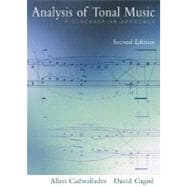
| Preface | p. xi |
| Basic Principles | p. 1 |
| Introduction | p. 3 |
| Beethoven, Piano Sonata, Op. 2, No. 1, I | p. 4 |
| Melody and Counterpoint | p. 15 |
| Melody | p. 15 |
| Counterpoint | p. 23 |
| A Sample Analysis | p. 35 |
| Bass Lines and Harmonic Structure | p. 41 |
| Tonic Harmony (T Class) | p. 42 |
| Intermediate Harmonies (Int Class) | p. 46 |
| Dominant Harmony (D Class) | p. 49 |
| Larger Contexts | p. 52 |
| The Imaginary Continuo | p. 62 |
| Chord Prolongation: Summary | p. 63 |
| Linear Techniques | p. 69 |
| Linear Progressions | p. 69 |
| Linear Intervallic Patterns | p. 80 |
| The Neighbor Note | p. 91 |
| Linear Intervallic Patterns: Summary | p. 93 |
| Tonal Structure | p. 99 |
| Notational Symbols | p. 99 |
| Tonal Structure and the Ursatz | p. 102 |
| The Bass Arpeggiation (Bassbrechung) | p. 107 |
| The Fundamental Line (Urlinie) | p. 108 |
| Structural Levels | p. 109 |
| The Principle of Interruption | p. 110 |
| More on the Ursatz | p. 114 |
| Techniques of Melodic Prolongation | p. 119 |
| The Initial Ascent | p. 119 |
| The Arpeggiated Ascent | p. 121 |
| Unfolding | p. 124 |
| Motion into an Inner Voice | p. 127 |
| Motion from an Inner Voice | p. 129 |
| Voice Exchange | p. 131 |
| Shift of Register | p. 134 |
| Descending and Ascending Register Transfer | p. 134 |
| Coupling | p. 137 |
| Superposition | p. 139 |
| Reaching Over | p. 139 |
| Cover Tone | p. 144 |
| Substitution | p. 147 |
| The Phrygian 2 | p. 147 |
| Mixture of Scale Degree 3 | p. 150 |
| Some Basic Elaborations of Fundamental Structures | p. 153 |
| Mozart, Piano Sonata, K. 283, I, bars 1-16 | p. 154 |
| Beethoven, Piano Sonata, Op. 14, No. 1, II, bars 1-16 | p. 159 |
| Beethoven, Piano Sonata, Op. 2, No. 1, II, bars 1-8 | p. 164 |
| Beethoven, Piano Sonata, Op. 10, No. 1, II, bars 1-16 | p. 170 |
| Mozart, Piano Concerto, K. 488, II, bars 1-12 | p. 177 |
| Beethoven, Piano Sonata, Op. 14, No. 2, I, bars 26-47 | p. 182 |
| Some Points for Review | p. 188 |
| Analytical Applications | p. 191 |
| One-Part Forms | p. 195 |
| Bach, Prelude in C major (WTC I) | p. 195 |
| Schubert, "Wandrers Nachtlied" | p. 201 |
| Schumann, "Lieb' Liebchen" | p. 208 |
| Binary Forms | p. 215 |
| Haydn, Piano Sonata, Hob. XVI/43, Minuet 2 | p. 216 |
| Mozart, Symphony No. 35, K. 385, Trio | p. 221 |
| Bach, Flute Sonata No. 2, Minuet 1 | p. 224 |
| Corelli, Violin Sonata, Op. 5, No. 10, Gavotte | p. 228 |
| Handel, Suite No. 5 in D minor, HWV 436, Menuetto | p. 231 |
| Bach, "Little" Prelude in C major, BWV 933, Menuetto | p. 234 |
| Auxiliary Cadences | p. 239 |
| Ternary Forms and Rondo | p. 243 |
| Beethoven, Bagatelle, Op. 119, No. 1 | p. 243 |
| Mendelssohn, Song Without Words, Op. 62, No. 1 | p. 253 |
| Schubert, Moment Musical, Op. 94, No. 2 | p. 263 |
| Haydn, Piano Sonata, Hob. XVI/37, III | p. 277 |
| Sonata Principle | p. 287 |
| Clementi, Sonatina, Op. 36, No. 1, I | p. 288 |
| Mozart, Symphony No. 35 ("Haffner"), K. 385, II | p. 294 |
| Mozart, Piano Sonata, K. 457, I | p. 304 |
| Some Common Tonal Patterns | p. 327 |
| Introduction | p. 327 |
| Binary Forms | p. 328 |
| Ternary Forms | p. 329 |
| Sonata Principle | p. 334 |
| Prolongational Spans | p. 340 |
| Mixture and Large-Scale Tonal Plans | p. 347 |
| Correspondence Between Patterns and Musical Examples | p. 349 |
| Introduction to Graphic Notation | p. 351 |
| Open Noteheads | p. 352 |
| Slurs and Filled-in Noteheads | p. 352 |
| Beams | p. 355 |
| Broken Ties | p. 355 |
| Stems with Flags | p. 357 |
| Diagonal Lines | p. 357 |
| Diagonal Lines and Beams | p. 360 |
| Rhythmic Notation at Lower Levels | p. 362 |
| Roman Numerals | p. 362 |
| Sample Graphic Analyses for Study | p. 365 |
| Examples from Free Composition | p. 368 |
| Notes | p. 369 |
| Selected Bibliography | p. 389 |
| Index of Musical Examples | p. 395 |
| Subject Index | p. 397 |
| Table of Contents provided by Ingram. All Rights Reserved. |
The New copy of this book will include any supplemental materials advertised. Please check the title of the book to determine if it should include any access cards, study guides, lab manuals, CDs, etc.
The Used, Rental and eBook copies of this book are not guaranteed to include any supplemental materials. Typically, only the book itself is included. This is true even if the title states it includes any access cards, study guides, lab manuals, CDs, etc.